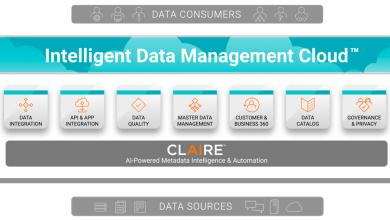
The cloud is now ubiquitous and it has become omnipresent storage for almost everyone. In fact, it is now used by organisations to store even their sensitive data and mission-critical workloads. And it appears it is also making on-premises storage anachronistic—or dated, to say the least. Having said that, is it now time to write obituaries for the old reliables in storage?
To find out, we asked data experts from different companies, “Are the days of on-prem storage numbered in the cloud era?” Here are their insights:

Some Data Still Needs to Stay On-Prem
While the cost-saving and scalability of the cloud has been undoubtedly beneficial for every organisation, many of them still have part of their data remain on-premises for security, governance or privacy reasons. Complete enterprise data migration to the cloud is a far cry for many organisations. It is crucial for businesses to have the ability to access, integrate and manage all of their enterprise data securely and instantaneously in a hybrid cloud environment.
– Ravi Shankar, Senior Vice President and Chief Marketing Officer at Denodo
Whether On-Prem or in the Cloud, Data Security Has to Be Top of the Mind
Data is at the heart of every business, and protecting data is key to continuity as losing control of it can cripple a business. Enterprises are migrating to the cloud for its flexibility and accessibility. However, whether a company has its data in the cloud, on-prem or a hybrid option, data security will always be paramount. As more IT teams juggle across multiple workload silos, it is crucial that there is a single unified platform for data protection in today’s multi and hybrid cloud environment.
– Daniel Tan, Pre-Sales Director, Japan, South East Asia, Korea, Hong Kong, Taiwan at Commvault
A Resounding “No”
Put simply, no. In today’s digital world, it’s not about storing data in a specific environment. It’s about having modern data management and security capabilities that support whatever storage environment a customer chooses. What organisations choose will depend on their regulatory obligations, industry, technology stack, databases and types of data they store. They may choose an on-prem approach, while others will adopt a hybrid model leveraging private or public clouds.
– Ravi Rajendran, Vice President, APJ at Cohesity
Expect An On-Prem Renaissance
It is helpful to view the cloud as a model rather than a destination. Through this lens, it is apparent organisations prefer the agility and flexibility that a cloud model offers. However, the cost associated with depending on just public cloud providers can be prohibitive. Pure Storage is seeing a trend of companies moving some of their workloads back to on-premises clouds from public clouds. The catalyst for this (besides a financial incentive), is that big advances have been made in the tools to do this simply and cheaply. We are moving to a world where most organisations will embrace a multi-cloud strategy to select the best model for specific uses.
– Matthew Oostveen, Chief Technology Officer & Vice President, Asia Pacific & Japan, Pure Storage
On-Prem Storage: A Pillar of Multi-Cloud
On-premises storage will remain a key pillar of multi-cloud strategies, largely for security and regulatory reasons, for organisations who have to retain sensitive and proprietary data on-premises and under direct management. Companies need a combination of a cloud and on-premises data centre to easily adapt as needs and regulations change. Our Multicloud Maturity Report found companies with such a multi-cloud strategy foster innovation and outperform the competition.
– Robert Yang, Vice President for Asia-Pacific Sales at Seagate
The Mainframe Is Here to Stay
On-prem solutions like mainframes have been the backbone of IT infrastructure for companies for decades because of their resilience, security and data governance. Organisations that modernise their mainframes and focus on a hybrid cloud solution are poised for success. The mainframe is around to stay—and will continue to power some of the largest institutions and organisations across the globe.
– Milan Shetti, President and CEO at Rocket Software
Sayonara, On-Prem Storage
Data is exploding due to digital transformation, the rise of Industry 4.0 and cloud projects. It is a matter of time before we will witness the demise of the on-prem storage era—the culprit behind large CO2 footprints, intensifying the energy crisis and working against corporate sustainability goals. Companies today are moving to cloud storage to help scale their business and reduce operating costs with improved visibility and consistency in order to drive business resilience.
– Dhiraj Goklani, Vice President, Observability, APAC at Splunk
Soon to Be a Second Choice
Each business has unique needs and priorities. Even as we increasingly move to the cloud, it is unlikely that on-premises storage will become irrelevant in the near future, given regulations and data sovereignty concerns. However, as businesses move toward becoming smart enterprises, we expect cloud storage to be the top choice for most. Aside from efficiency and scalability, cloud storage makes it easy to create data lakes or warehouses to derive insights for better decision-making, productivity and customer-centricity.
– Darrell Goh, Head of Sales in Southeast Asia at Xtremax
A Slow Death for Traditional On-Prem Storage
Organisations are increasingly adopting cloud storage solutions to reduce operating costs, and have more control over security and for remote access to data. Today, on-premises storage is used more for legacy services, high-performance applications and to meet regulatory requirements. With rapid digitalisation, we expect more organisations to move away from on-prem to hybrid or cloud storage that supports both traditional block, file and object workloads, and newer storage constructs like containerised workloads with persistent storage.
– Scott Kennedy, Solutions Lead, Cloud and Infrastructure Service, APAC, at DXC Technology
Cloud: The New Dominant Force
Cloud storage is set to enter a new age of domination over on-prem storage. Businesses today are capitalising on opportunities to drive agility, reduce risk, eliminate costs and protect data against disasters. This comes down to the way it stores its data and apps too. To that end, cloud storage is the answer—but only if it’s accompanied by the right backup and disaster recovery strategy to quickly restore from potential compromises. Traditional on-prem storage will quickly deplete in this era of resilience.
– Jeffrey Neo, Managing Director, Southeast Asia & Korea, at Micro Focus
Hybrid Multi-Cloud Is the Next Frontier
More firms are adopting hybrid multi-cloud to enjoy the reliability of the data centre with the scale of the cloud. While on-prem storage still has a role to play, transitioning to the cloud gives enterprises clear agility, sustainability and cost benefits. As we forge ahead into the new phase of the evolved cloud, NetApp is helping enterprises unlock the best of the cloud through a unified approach that optimises efficiency, maximises flexibility and reduces risk, whether the data resides in the cloud or on-prem.
– Sanjay Rohatgi, Senior Vice President and General Manager, Asia Pacific & Japan, at NetApp




